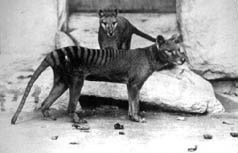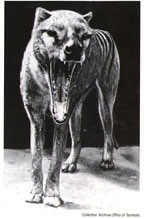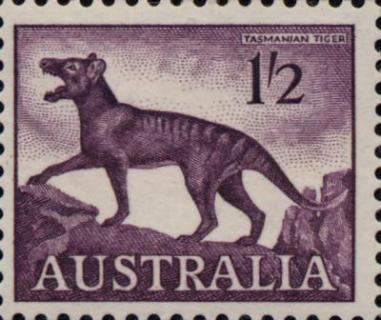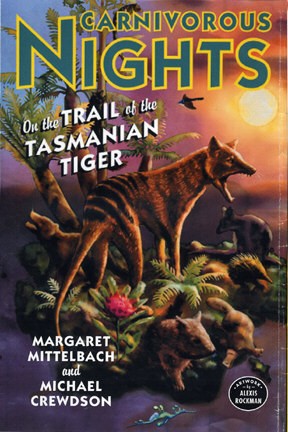
September 6, 2006

The 70th anniversary of the Thylacine’s extinction is September 7th! Do they still walk among us? Did Steve Irwin see one in Tasmania?
The last captive thylacine died in the Hobart Zoo on September 7, 1936. Today in Australia, the day is now known as “Threatened Species Day.” Ten years ago it was known as “National Thylacine Day.”

The last thylacine (third one pictured below) was captured in 1924, with its mother and siblings, in Florentine Valley, Tasmania. In 1933, this last thylacine, a female, was sold to the Hobart Zoo. (Whether or not it was ever named “Benjamin” is a subject of much debate.) The world’s last captive then died in that zoo three years later. In the same year, 1936, or in 1938, by some accounts, the Tasmanian tiger was added to the list of Protected Wildlife. Finally, 50 years after the death of the last captive, in 1986, the thylacine was declared extinct by international standards.
But sightings in the wild persist. Do they live today out in the forest bush of Tasmania (almost 400 sightings), on mainland Australia (over 4000 sightings), or in the rainforests of New Guinea (a handful)?



As mentioned earlier this week, the late Steve Irwin went to Tasmania and filmed an episode of “The Crocodile Hunter” about the search for the Thylacine or Tasmanian Tiger. He reportedly may have captured footage of a Thylacine. (Read more on this angle here at Steve Irwin #1 and Steve Irwin #2.)

The Thylacine today is the subject of much discussion and searching within cryptozoology. The cryptid, for example, is the subject of one of the best cryptozoology books of recent years, Carnivorous Nights: On the Trail of the Tasmanian Tiger, shown here with well-known artist Alexis Rockman’s cover, in all of the spectacular colors of the Tasmania rainforest.

Many locations have good museum collections educating the public on the Thylacine, especially in Australia and Tasmania. In the United States, in the traveling exhibition, at Bates College’s Museum of Art and Kansas City’s H&R Artspace, Cryptozoology: Out of Time Place Scale, many exhibits are tied to the thylacine, including more Rockman paintings, a full-size steel thylacine sculpture by Rachel Berwick, the continuous running of the last footage of the Hobart Zoo thylacine, Tasmanian tiger popular culture souvenirs from Jeffrey Vallace’s collection, and a 2001 footcast of an allegedly post-extinction Thylacine encounter and other items from my cryptozoology museum.
Will evidence of the Thylacine be found in the next decade? In 1984, Ted Turner offered a $100,000 reward for proof of the continued existence of the Thylacine. It went unclaimed by the time it was withdrawn at the end of the 20th century. Reportedly still current, an offer of $1.75 million (probably Australian dollars) has subsequently been offered by a Tasmanian tour operator, Stewart Malcolm, but this is also unclaimed today.
Click on this 1910 image for a full-sized version
Thanks to the one-sentence reminder from Chris Rehberg in Sydney about this anniversary, which stimulated me to write the above and share these images with you. Rehberg has likewise decided to author his own reflective moment about this event at “70 years extinct! Or is it?”
^^^^^^^Later^^^^^
Xeni Jardin at Boing Boing acknowledges this story, in “Get ready for National Thylacine Day, Sept. 7!”. And as she learned, the Thylacine (Thylacinus cynocephalus) is not a feline, but a “tiger” only in looks. It’s a dog-sized carnivorous marsupial.
About Loren Coleman
Loren Coleman is one of the world’s leading cryptozoologists, some say “the” leading living cryptozoologist. Certainly, he is acknowledged as the current living American researcher and writer who has most popularized cryptozoology in the late 20th and early 21st centuries.
Starting his fieldwork and investigations in 1960, after traveling and trekking extensively in pursuit of cryptozoological mysteries, Coleman began writing to share his experiences in 1969. An honorary member of Ivan T. Sanderson’s Society for the Investigation of the Unexplained in the 1970s, Coleman has been bestowed with similar honorary memberships of the North Idaho College Cryptozoology Club in 1983, and in subsequent years, that of the British Columbia Scientific Cryptozoology Club, CryptoSafari International, and other international organizations. He was also a Life Member and Benefactor of the International Society of Cryptozoology (now-defunct).
Loren Coleman’s daily blog, as a member of the Cryptomundo Team, served as an ongoing avenue of communication for the ever-growing body of cryptozoo news from 2005 through 2013. He returned as an infrequent contributor beginning Halloween week of 2015.
Coleman is the founder in 2003, and current director of the International Cryptozoology Museum in Portland, Maine.
Filed under Breaking News, Cryptotourism, CryptoZoo News, Cryptozoologists, Cryptozoology, Thylacine